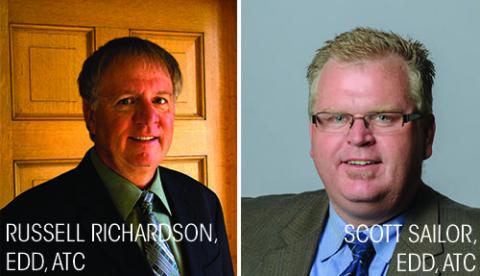
NATA is pleased to introduce your 2014 presidential candidates: Russ Richardson, EdD, ATC, and Scott Sailor, EdD, ATC. Voting will take place Sept. 1-30, so be checking your email inbox for voting informaiton in the coming months. We'll be publishing expanded profiles in the August/September issue of the NATA News. Scroll to the end of the post to watch a video of the candidates presenting their platforms and answering questions at Face Time 2014 in Indianapolis.
NATA member since: 1979
If elected president, Richardson plans to focus on raising athletic training’s profile within the health care arena. He said the profession has grown tremendously in the past five years but still lacks a clear roadmap for moving forward. “I would advocate for a new strategic planning process to reinforce our current direction as well as clearly direct us for our future. Like most roadmaps, directions change and modify frequently,” Richardson said. “Our association needs to be mobile, agile and nimble enough to ensure our safe arrival at our final destination.”
Richardson says a hallmark of a vibrant, health care profession is its commitment towards continuous academic development for all of its constituents. “In my current role as the Executive Committee for Education chair I was able to direct complex, and sometimes controversial discussions leading to the implementation of strategic initiatives that had previously only been talked about,” he says. “As a practicing clinician, and former academician, I have experienced firsthand the complexities of each entity and have worked to bridge the gap between the two.”
Richardson says he hears two common themes from members: “We need more job opportunities, and we need improved compensation.” One of the strategies he believes will move ATs towards better job opportunities includes equipping our members to advocate for their compensation through the medical model. “We are currently working on a plan to identify resources and provide examples of this strategy to make available to our membership early next year,” he says.
Finally, Richardson wants to further develop the association’s position as a leader in youth sports safety and other issues related to concussion in sport. He knows NATA members can help make a difference and wants to empower ATs across the country to get involved. “I have been rewarded many times over as I have witnessed our members be successful not only in patient care, but legislative issues, complex leadership issues, litigations and more.”
Name: Scott R. Sailor, EdD, ATC
Job Title/Employer: Chair of the Department of Kinesiology and program director for the AT program at Fresno State University
NATA member since: 1985
Sailor’s presidential platform can be summed up in three words: access, awareness and allies. Sailor would like to see improved access to athletic trainers in secondary schools and youth-sports organizations. Sailor points out that many schools throughout the country lack adequate staffing of athletic trainers, so those ATs are often required to scale back the services they provide in order to meet the overwhelming demand. He plans to work toward making athletic trainers more accessible to the general population, especially adults who need help returning to their active lives after an injury. “I envision a day when members of the public consider consulting an athletic trainer a normal part of an active lifestyle, much like they currently consider consulting personal trainers prior to undertaking a fitness program,” says Sailor.
Though Sailor says awareness of athletic training has improved in recent years, he believes NATA members need to continue to raise awareness about their knowledge, abilities and clinical research. Sailor wants to continue to emphasize the AT’s role in the management of concussions, sudden cardiac arrest and heat illness. “I believe we will soon see a day where athletic trainers are fully engaged and leading health policy discussions, especially when it comes to topics related to youth sports safety,” he says.
He thinks those grassroots efforts, along with the association’s collaborations with likeminded organizations that understand the value of athletic trainers, will continue to raise the profession’s public profile. Sailor points to the importance of engaging and maintaining serious dialog with long-standing allies about issues such as appropriate models of supervision for ATs, rules changes and growing demands on student-athletes and athletic training staffs. “It is imperative, as we move forward, that we [strategic allies] work together to bring about positive change for this profession which will result in improved outcomes for our various stakeholders.”
Face Time 2014: Presidential Platforms from National Athletic Trainers' Assn on Vimeo.
This information was first published in the Convention Daily News.
Posted by NATA News Editor-in-Chief Jordan Grantham (jordang@nata.org).





